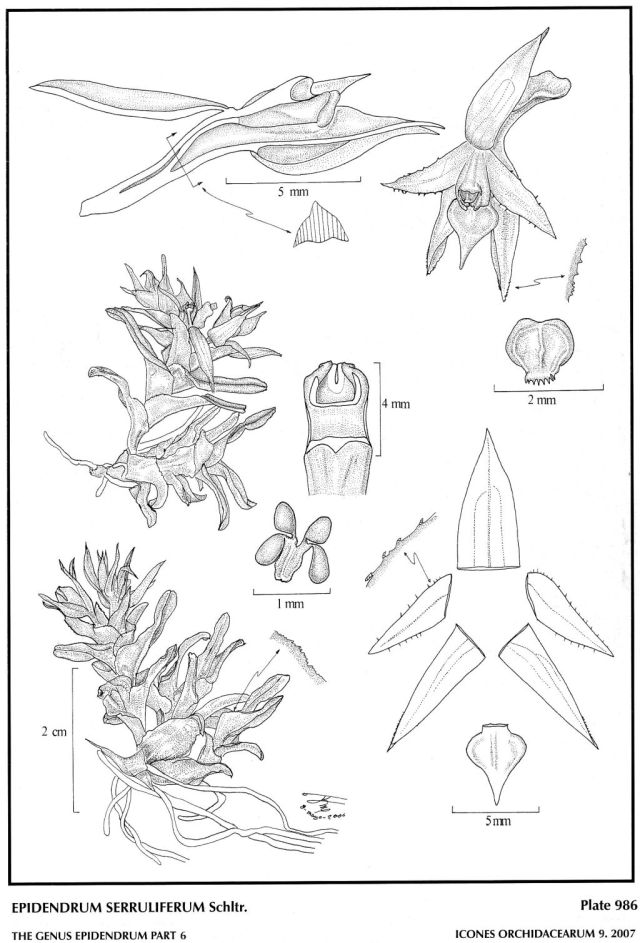

Epidendrum serruliferum Schltr. 1923 GROUP Nanodes
Drawing by © Jimenez and The AMO Herbaria Website


 LATE
LATE  EARLY
EARLY 
Common Name The Saw Edged Epidendrum [refers to the dentate margins of the lateral sepals]
Flower Size .6" [1.5 cm] wide
Found in Costa Rica and Panama at elevations of 600 to 1500 meters as a mini-miniature sized, warm to cool growing epiphyte with simple, cane-like, laterally compressed, erect stems enveloped completly by leaf sheaths and carrying 5 to 8, all along the stem, distichous, spreading, unequal, non-articulate, somewhat basally imbricate, succulent, linear to oblong-lanceolate, amplexicaul and conduplicate basally, obtuse, unequally bilobed, margin hyaline, somewhat revolute, slightly basally erose, dentate apically leaves that blooms in the late fall and early winter on a terminal, sessile, occuring only once, simultaneously 3 flowered inflorescence with slightly longer than the ovary, unequal in size, widely triangular, conduplicate, acute, amplexicaul, margin dentate floral bracts and carrying erect, more or less resupinate, delicately fleshy, green flowers.
"Epidendrum serruliferum belongs to the GROUP Nanodes , characterized by the caespitose to creeping, sympodial plants, the short stems completely covered by the base of the non-articulate, fleshy, imbricating leaves and sessile, few-flowered inflorescences. The species is recognized by the short plants .6 to 1.4" to sometimes 2" [1.5 to 3.5 to sometimes ca.5 cm] tall with 3 greenish flowers, the floral bracts widely triangular, acute, the floral segments short-acuminate, the margin of the petals scarcely ciliate, the basal half of the lip transversely elliptic, the apical half triangular-acuminate, the margin of the clinandrium-hood entire and slightly undulate. It has been confusea¿ with Epidendrum congestum Rolfe which has 2 to 3 greenish flowers, occasionally tinged with reddish purple, the emerald-green lip cordiform, the floral bracts ovate and rounded, the floral segments acute to subacute, the margin of the petals erose-dentate, and the clinandrium-hood slightly erose. Epidendrum congestoides Ames & c. Schweinf. has acute sepals, the reniform-semiorbicular lip embracing the column in natural position with the margin hyaline, erose-dentate and the margin of the clinandrium-hood short fimbriate-dentate. Epidendrum schlechterianum Ames has relatively long, greenish purple to olive green flowers tinged with red, oblong-Ianceolate sepals .68 to .8" [17 to 20 mm] long, and the lip cordate-renlform, mlnutely apiculate, the column .4 to .56" [10 to 14 mm] long with the anther long, narrowly ovoid with the apical margin short-fimbriate and the surface strongly papillose. Epidendrum oxynanodes Hágsater from western Colombia has the largest flowers of the group with sepals .882 [22 mm] long with narrow, acuminate floral segments, including the ovate-acuminate lip, and the clinandrium hood has a few prominent teeth along the margin. Epidendrum uleinanodes Hágsater from Manaus has a fimbriate clinandrium-hood and prominent, upturned, rounded lobes at the apex of the column, with the lip widely reniform and deeply cordate." Hagsater etal 2007
Synonyms
References W3 Tropicos, Kew Monocot list , IPNI ; *Repert. Sp. Nov. Regni. Veg. Beih. 19: 44. Costa Rica Schlechter 1923; The Flora of Panama L O Williams 1946 as E congestum; Icones Orchidacearum 9 Plate 921 Hagsater 2007 see recognition section; Icones Orchidacearum 9 plate 986 Hagsater & Santiago 2007 Drawing fide;
----------------------------------------------------------------------------------------------------------